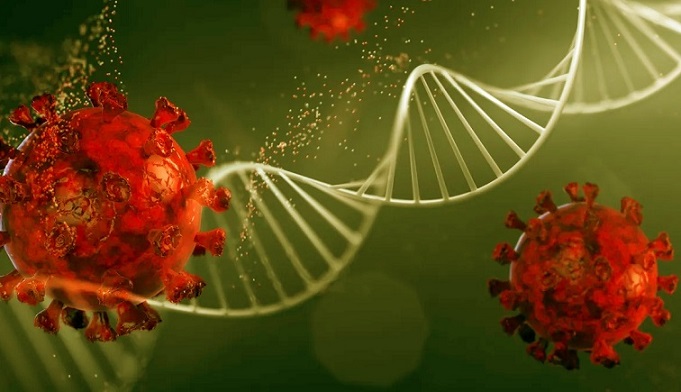SARS-CoV-2 Nsp1 Protein Stalls Human DNA Replication, Contributing to Dangerous Long-Term Health Issues!
Nikhil Prasad Fact checked by:Thailand Medical News Team May 23, 2025 7 months, 1 day, 6 hours, 25 minutes ago
Medical News: Shuts Down Key Human DNA Enzyme Blocking Replication and Triggering Inflammation
In a new discovery that adds another disturbing layer to the complex ways SARS-CoV-2 damages human cells, scientists from the Eppley Institute for Research in Cancer and Allied Diseases and the Fred and Pamela Buffett Cancer Center at the University of Nebraska Medical Center have found that one of the virus's key proteins, Nsp1, disrupts the function of a vital human DNA enzyme.
 SARS-CoV-2 Nsp1 Protein Stalls Human DNA Replication, Contributing to Dangerous Long-Term Health Issues!
SARS-CoV-2 Nsp1 Protein Stalls Human DNA Replication, Contributing to Dangerous Long-Term Health Issues!
The study, published in Scientific Reports, reveals that the Nsp1 protein—already known for suppressing the body’s immune responses—also stalls DNA replication by binding tightly to DNA polymerase alpha (Polα), an enzyme crucial for copying our genetic material. This
Medical News report explains that the interference occurs specifically at fragile DNA regions prone to forming "hairpin" loops—areas where the DNA folds in on itself like a bobby pin, which are already difficult to replicate.
A Molecular Hijacking That Halts DNA Synthesis
Nsp1 is one of the first proteins SARS-CoV-2 makes after entering the body. Its role in sabotaging immune defenses was already known. It blocks production of vital antiviral proteins and stops cells from exporting essential messages (mRNA) needed to make other protective proteins. Now, the new study shows that Nsp1 goes even further by physically binding to Polα and stalling its work.
DNA polymerase alpha normally works alongside another helper protein called RPA to copy DNA, even across tricky hairpin structures. But when Nsp1 latches onto Polα, it muscles out RPA and blocks this process. In lab experiments, adding Nsp1 to Polα drastically reduced its ability to copy hairpin DNA—by up to eight times more than RPA could.
Interestingly, a mutated version of Nsp1 that could no longer bind Polα restored the enzyme’s ability to copy DNA. This proves that Nsp1’s direct binding to Polα is responsible for the disruption.
Why This Matters for COVID-19 Patients
This interference might help explain why COVID-19, especially in its severe forms, is often accompanied by extreme inflammation and immune system dysfunction. When DNA replication stalls, it can leave broken fragments or abnormal signals in the cell that trigger powerful immune responses. These include the release of cytokines—molecules that contribute to the dreaded “cytokine storm” seen in critical COVID-19 cases.
Moreover, researchers suspect that Nsp1’s actions might interfere with the creation of telomeres—protective caps at the end of chromosomes—and slow the division of immune cells like T and B lymphocytes, which are key to fighting off infections.
A De
eper Molecular Match
Structural modeling in the study also revealed why Nsp1 binds so strongly to Polα. It has a larger interaction surface with the enzyme than RPA does, forming more hydrogen bonds and hydrophobic contacts. This allows Nsp1 to outcompete RPA for access to Polα, effectively hijacking the enzyme and preventing it from doing its job.
Experiments measured the concentration of Nsp1 needed to halve Polα activity (the IC50) at just 1 µM, compared to 8 µM for RPA’s helper domain. That’s a striking difference—and one that may have serious implications for how the virus replicates and evades our immune system.
Conclusions and Implications
The findings suggest that SARS-CoV-2 uses its Nsp1 protein not only to shut down antiviral signaling but also to stall host DNA replication by targeting the Polα enzyme, especially in regions that are already replication-challenged. This could lead to an accumulation of DNA fragments in the cell’s cytoplasm, potentially setting off powerful inflammation through the cGAS-STING pathway. Such disruptions might also contribute to long-term symptoms seen in many COVID-19 survivors, known as Long COVID. Understanding this new function of Nsp1 opens the door to new therapeutic targets aimed at preserving Polα function and mitigating the cellular havoc caused by the virus.
The study findings were published in the peer reviewed journal: Scientific Reports.
https://www.nature.com/articles/s41598-025-00982-8
For the latest COVID-19 News, keep on logging to Thailand
Medical News.
Read Also:
https://www.thailandmedical.news/news/covid-19-causes-exponential-dna-methylation-in-the-tas2r38-gene
https://www.thailandmedical.news/news/belgium-scientists-provide-new-insights-into-dna-methylation-telomere-length-and-immune-function-in-long-covid-patients
https://www.thailandmedical.news/news/covid-19-news-harvard-and-mit-study-alarmingly-shows-that-sars-cov-2-rna-integrates-into-human-genome-with-varying-implications
https://www.thailandmedical.news/articles/coronavirus
https://www.thailandmedical.news/pages/thailand_doctors_listings
